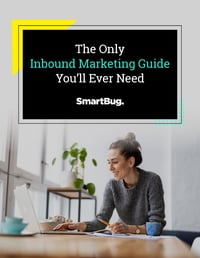
By Kate Ference
I remember my first marketing job like it was yesterday. My boss, the marketing director at the time, asked me: “Do you know what inbound marketing is?”
I knew marketing was about branding, sharing product information, and understanding consumer psychology. Getting a business’s name out there is important, but I hadn’t realized there were legitimate philosophies behind marketing—especially digital marketing.
My boss told me about inbound versus outbound marketing. She explained inbound marketing is a methodology, all about serving the right content to the right person at the right time.
What Is Inbound Marketing?
Inbound marketing is about drawing a prospective customer into your brand, business, or product through useful information that solves a pain point. It’s about attracting consumers to support your business through campaigns—whether they’re informative, funny, or socially inspiring—and forming a connection with them by helping them find whatever they’re looking for.
This can look like someone coming to your website, clicking a social media post, or downloading literature about a question they’re asking. The foundation of inbound marketing is content. Different tools are used to build this content—including search engine optimization (SEO), business blogging, and more—and analyze the performance data to scope your marketing efforts.
The Inbound Methodology
HubSpot, a customer relationship management (CRM) platform used for inbound marketing, explains the buyer’s journey with a flywheel. You should be there for the individual (prospect or customer) through every step of their journey
and beyond.
The Stages of the Flywheel
- Step 1: Attract
- Step 2: Engage
- Step 3: Delight
Although we know marketers love branding and communication, we do get extra excited when it comes to our marketing language. It’s important to understand the terms used to describe inbound marketing so you can communicate effectively with your peers, partners, and clients.
But just like some marketing leads are better than others, you’ve got to remember that quantity isn’t necessarily the most important factor with inbound marketing terms.
Just like marketing needs to zone in on quality leads that will be the most meaningful conversions, it’s also important to have a solid knowledge of the most essential inbound marketing terms.
That’s why we’ve lasered in on inbound marketing lingo that will get you the most bang for your buck in digital marketing. Check out our top inbound terms below:
A
A/B Testing
Marketing is a business science, meaning it includes a bit of psychology. To find out what campaigns or pieces of content perform best, you can conduct an A/B test. A/B tests take one item to test—like a landing page template or ad graphic—and measure which generates the most views or conversions. It’s important to make your A/B tests measurable so you can compare results and implement the top choice. A/B tests are usually performed for about a month.
Automation
Automation goes hand in hand with marketing these days. It’s vital to incorporate marketing automation into campaigns by using technology to perform certain communications. Consider marketing automation as a tool to develop something like a lead nurturing strategy, in which you would create a workflow with triggers to distribute targeted and personalized communications.
B
B2B (Business to Business)
These are businesses that sell products or services to other businesses. For example, a software company selling custom services for a website to another company would be B2B.
B2C (Business to Consumer)
These are businesses that sell directly to individual consumers, such as a higher education institution attracting students or a retail organization selling a tie-dye hoodie to a buyer scrolling on Instagram.
Bottom of Funnel (BOFU)
Bottom of funnel, also known as BOFU, refers to the final stage of the buyer’s journey, in which leads are closest to converting to customers. They are in the decision stage of the buyer’s journey, so they have already identified a problem and considered multiple solutions. The next step after BOFU is most commonly a demo or contact from a salesperson.
C
Call to Action (CTA)
“CTA all day” is any marketer’s motto. A call to action is a request for your audience to complete the next prompt, usually at the end of the current content. This could look like a “Download Now” button in an email or an image at the bottom of a blog post with a link to a landing page. CTAs can be created with code and tracked to measure which content drives more leads to the next step of the marketing funnel.
Conversion Rate Optimization (CRO)
Conversion rate optimization (CRO) is the process of determining whether or not a website is converting new leads. By analyzing form placement, website copy, layouts, and more, CRO uses testing and website audit tools to determine what changes you can make to a website that will get the most leads converted.
D
Dynamic Content
Also known as smart content, dynamic content offers viewers specialized content based on their contact data. Dynamic content is increasingly used in inbound digital marketing on websites, in email, or within blog content to show personalized content or campaigns that make the most sense to the individual (e.g., their buyer’s journey stage, the type of product they are interested in).
E
Evergreen Content
Evergreen content stays relevant as time progresses so readers can find it useful again and again. Even if the publish date of the content is months or years old, search engines prompt users to view it, meaning it is high quality and more likely to convert leads.
F
Forms
A form is an area on a website landing page where visitors can provide contact information, including their first name, last name, email, and job title. This is in exchange for your content or a subscription, like an email newsletter. The less information required on a form, the more likely a reader will complete it. Conversely, the more information you obtain, the better you can qualify leads and generate personalized content to send them.
G
Google
Google is increasingly clutch when it comes to inbound marketing. Not only is it a search engine dishing organic traffic to a website, but its analytics are also key to reviewing data and determining your marketing strategy. Make sure to track page views and visitor sessions in Google Analytics (converting to GA4 in July 2023) and index blog posts in Google Search Console even before they’re crawled. Check out Google’s GA4 Certification.
H
Hashtag
You can’t have social media without the hashtag. Written with a # symbol, hashtags enable words or phrases to be searchable across social media platforms. They can be used as categories and tie conversations together on a platform to read as a thread.
I
Infographic
What is an infographic? An infographic can be categorized as any extremely visual content, although they’re often used to showcase complicated topics in a simple way with icons, illustrations, or text.
J
JavaScript
JavaScript is a text-based programming language that lets coders create interactive elements on a website page. JavaScript takes the HTML (HyperText Markup Language) and CSS (Cascading Style Sheets) code and transforms it into clickable buttons and an actual web experience, rather than just text or color on
a page.
K
Key Performance Indicator (KPI)
Key performance indicators are business speak for goals. This measurement can be tied to a company’s overarching business goals or broken down into sales or marketing goals. They are usually evaluated quarter over quarter (QoQ) or year over year (YoY) to determine how a business is performing. KPI metrics are good indicators of where to improve and can show leaders where to place their efforts for the best results against industry standards.
L
Lifecycle Stage
Lifecycle stages are becoming more vital throughout the buyer’s journey as data analysis continues to grow within inbound marketing. Lifecycle stages are the phase of a lead along the funnel. These stages may include marketing-qualified lead (MQL), sales-qualified lead (SQL), customer, promoter, or evangelist. Watch as your leads change lifecycle stages and track them to understand their ROI and how they can be re-engaged.
M
Meta Description
A meta description doesn’t influence search engine rankings, but it does serve as a general summary of a webpage. It’s the sentence or two that appears in search engine results pages (SERPs) below a title. It is technically an HTML element, and the recommended length is under 155 characters, or else the text will be cut from the SERP.
Middle of Funnel (MOFU)
Middle of funnel (MOFU) refers to the middle of the sales and marketing funnel in which potential buyers have identified their problem but are still searching for their solution. The middle of the funnel is categorized as the consideration stage of the buyer’s journey, so offers like brochures and case studies are most effective.
N
Net Promoter Score (NPS)
Customers and their opinions are the real deal. Customer referrals are some of the top drivers of sales. And in the digital world of social media, anyone can comment and make or break a brand and its products. Net promoter scores (NPSs) are a way to capture customer satisfaction on a scale of 0-10 and determine whether they would refer your product or services to others. This metric should be evaluated regularly through surveys. Here’s how to calculate your NPS.
O
Opt-In
This term is a biggie. As technology advances to capture and leverage customer data in new ways, there is also a privacy movement to ensure the ethics and values of marketing stay intact. As we get closer to saying goodbye to cookies, ensuring that your brand reaches out to prospective customers who are genuinely interested and have agreed to communications is the way to go. Though we’re not legal experts, marketing communications certainly need to be legal, meaning individuals have opted into them, whether they do so with a checkbox on your site or a click of a CTA button.
P
Page Views
Page views are a standard inbound marketing metric for websites. This is not an individual visitor—a page view means that one page of your website has been seen. And the more, the merrier! Page views are a good way to evaluate your website content and templates to see what’s working.
Q
Qualified Lead
A qualified lead is a potential customer that has taken an action to show interest in your product or service. This could be opting into email communications or completing a form on your website that prompts a contact from sales.
QR Code
Short for “quick response code,” a QR code is a two-dimensional barcode that directs users to specific content when scanned by a smartphone camera or a QR reader. These codes have historically been black modules on a white square. However, QR codes continue to advance, and now even animated QR codes
are possible.
R
Return on Investment (ROI)
Arguably one of the most important inbound marketing terms (to your sales leader, that is), ROI is a measurement of how much you gain from an initial investment and whether that action was worth it. For example, did the sales and marketing funds you spent on a trade show booth result in a sales-qualified lead who bought your product or service? The ROI on the trade show would determine whether you should participate again next year. Sometimes one lead is all it takes to achieve ROI, depending on the sales amount versus the cost of the trade show.
S
Search Engine Optimization (SEO)
There is a lot to unpack with search engine optimization and its best practices for inbound marketing. From evaluating keywords to optimizing websites for a higher ranking on SERPs, you want to continually evaluate on-page and off-page SEO so that your brand’s contact is visible, highly valued, and authentic. Tools like Semrush and Moz are great places to start with SEO.
Service-Level Agreement (SLA)
This agreement between an organization’s marketing and sales teams breaks out the expectations for each department, such as how to qualify leads between sales-qualified leads (SQLs) and marketing-qualified leads (MQLs). The purpose of the agreement is to align goals and prevent siloed departments.
T
Thank You Page
This is a non-indexed landing page, meaning non-public facing on your website. This landing page houses your gated content, such as a guide or white paper. Don’t forget to add the no-follow HTML code to the TYP so that search engines will not crawl it: <META NAME="robots" CONTENT="noindex,nofollow">
Top of Funnel (TOFU)
Top of funnel (TOFU) is part of the awareness stage in the buyer’s journey, in which leads are in the first stage of the buying process and further away from a sales conversion. This is the stage in which it is most beneficial to offer thoughtful content that identifies a buyer’s pain point and provides additional information to solve it.
U
User Experience (UX)
User experience (UX) is the holistic experience a user has with an organization or product, from the initial awareness phase to the end of the buyer’s journey. UX can also refer to the specific digital user experience when someone utilizes software or a website.
User Interface (UI)
Not to be confused with user experience, user interface (UI) is the look, feel, and application of software or hardware. For example, the website navigation or software menu toolbar and buttons that appear for someone online on a specific site make up a user-friendly UI.
V
Viral Content
When content goes viral, it reaches a high level of digital coverage across the internet. Sometimes viral content can be personal social media posts or unfortunate or embarrassing content. However, marketers will want to create viral content that is positive for their brand strategy and increases website traffic.
W
Webinar
A webinar, short for “web seminar,” is an online presentation. It is also digital marketing gold. Whether live or on-demand, webinars are video casts of educational content in which brands can address a topic in thought leadership or explore product launches that inform customers.
White Paper
A white paper is a must-have in your content marketing library and serves as a tangible takeaway on a website, usually in the form of a PDF guide.
Workflow
Workflows are any effort to convert a new marketing or sales lead, usually part of marketing automation. From a conversion path to email marketing, workflows can be developed in a CRM platform like HubSpot or MailChimp to deliver an action—for example, an external email communication—to individual contacts when they meet a certain trigger, like viewing a website page.
X
XML Site Map
This is the official name of a site map. What is a site map? It’s a file of code that lists all of a website’s content and pages, or URLs. A site map can be seen as the structure of a website, but is also very important for a search engine to “crawl” so that a page shows up in search results.
Y
YouTube
This is just one of many digital channels (in a non-exhaustive list of Instagram, Facebook, LinkedIn, Twitter, Reddit, and more). If your brand isn’t on YouTube yet, get on it. This website is a free video platform where users can upload and share video content. Due to its interactive user features, like comments, YouTube is often considered social media, but is dually known as a business-focused advertising source. Now owned by Google, it’s the second most visited search engine in the world—ironically, right behind Google.
Z
Zero-Cost Strategy
Marketing campaigns don’t always have to have a ton of dollars behind them to be successful. The concept of zero-cost strategy—or a tactic or decision that doesn’t cost anything to execute—can sometimes be the most beneficial to brand awareness and perception. For example, a viral social media trend like the ”ice bucket challenge” for ALS had an exceptional outcome with low upfront costs. Another example of zero-cost strategy marketing is a cause-driven campaign with purpose-driven marketing around climate change support. This tactic is a reminder that you never know how successful one inbound marketing strategy can be for a brand, product, or service.
Profound Communication = Impactful Marketing
Hopefully these terms will serve as a continued reference for you and help you drive conversions during times of uncertainty, product launches, and more.
Because inbound marketing serves to connect consumers with brands, inbound marketers need to focus on communicating effectively so brands can get their message across.
Marketers speak from so many perspectives to everyone—whether it’s B2B, B2C, distributors, or existing customers. That means profound communication is the key to successful marketing. The better the communication, the stronger the brand connection, meaning more impactful marketing overall.
So now that you know how to talk the talk, you can officially walk the walk and convert those MQLs down the funnel to meet your KPIs with the most ROI.
Interested in exploring practical inbound marketing strategies that create better leads? Download The Only Inbound Marketing Guide You’ll Ever Need.

About the author
Kate Ference is a Senior Account Specialist at SmartBug Media. Kate developed a passion for the power of inbound marketing through her experience with B2B SaaS. She’s always thinking about how HubSpot can leverage marketing automation for brands and believes that MarTech is the future of marketing! Read more articles by Kate Ference.







